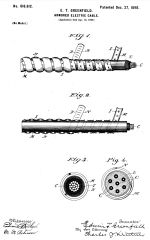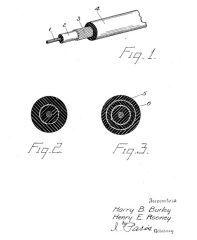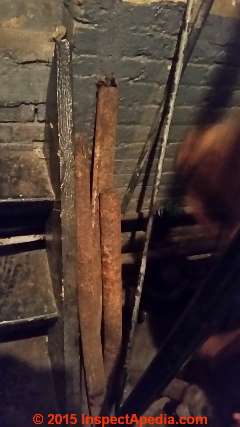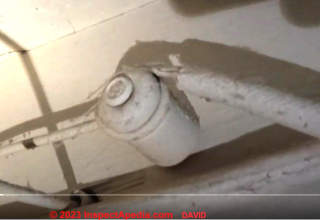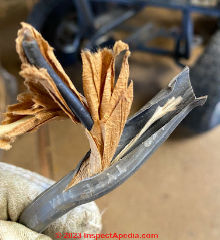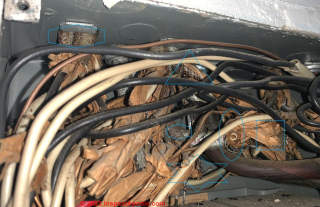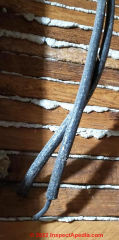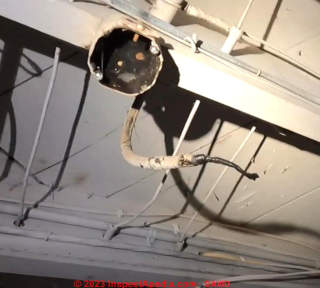 Old Electrical Wiring HIstory
Old Electrical Wiring HIstory
Early Chronology & Research History of Types of Electrical Wiring in Older buildings
- POST a QUESTION or COMMENT about old house wiring, knob & tube, old fuse panels, old house wiring
History of electrical wire & electrical wiring.
Here are key research articles and patent citations that trace the earliest development of electrical wire and that name key inventors such as Edisonand Greenfield.
Page top photo: antique knob and tube wiring in an older U.S. home.
InspectAPedia tolerates no conflicts of interest. We have no relationship with advertisers, products, or services discussed at this website.
- Daniel Friedman, Publisher/Editor/Author - See WHO ARE WE?
Old Electrical Wire Patent History
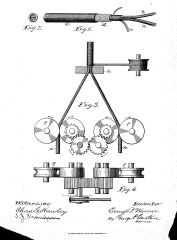 Above: illustration from Warner's 1890 patent of a method for manufacturing electric conductors.
Above: illustration from Warner's 1890 patent of a method for manufacturing electric conductors.
[Click to enlarge any image]
Given below, in order by patent date, are examples of early U.S. patents that help provide invention and first-use dates for types of electrical wiring and electrical wire conductor insulation and insulating sheathing.
Separately at OLD ELECTRICAL WIRING TYPES you will find we provide a timeline of early electrical wiring invention, properties, types, and examples of different types of electrical wires or wire insulation and sheathing or jackets.
There you'll also find our photo guide to all types of old building electrical wires.
Also separately, at OLD HOUSE ELECTRICAL SYSTEMS we give advice for inspecting & repairing old house or old building electrical wiring and we describe and illustrate common unsafe conditions at old electrical wiring installations.
- Edison, Thomas A. "Electrical Indicator" U.S. Patent 307,031, issued October 21, 1884.
Abstract:
The object of my invention is to produce an efficient apparatus for indicating variations of electro-motive force in an electric circuit, preferably for use in connection with systems of electrical distribution to show the changes in pressure in the various parts of the district.
- Warner, E.P., METHOD of MANUFACTURING ELECTRICAL CONDUCTORS [PDF] US466268A [PDF] U.S. Patent US466268A issued August 5, 1890
Excerpt:
My invention relates to the manufacture of double-stranded electric conducting-cords; and its object is to produce a cord which shall be of moderate diameter, thoroughly insulated, and at the same time protected from external injury.
- Edison, Thomas A. ELECTRIC CONDUCTOR [PDF] U.S. Patent 470,924, issued March 15, 1892.
Excerpt:
To all whom it may concern: Be it known that I, THOMAS A. EDISON, o Llewellyn Park, in the county of Essex and State of New Jersey, have invented a certain new and useful Improvement in Electrical Conductors, (Case No. 732,) of which the following is a specification.
The object of my invention is to effectively insulate wire, so that it will be waterproof and capable of being used in moist places and even under water without detriment to its insulating qualities, and also fire-proof, so that if by accident the wire becomes red-hot the insulating-covering will not be set on fire and burned, but only oxidation Will result, which will leave the wire pyro-insulated.
The main feature of the invention is the use as an insulating-covering of a mixture of rubber with an infusible material in the form of a powder.
I prefer to employ crude gum rubber, which I soften or partially dissolve by a suitable solvent such as benzole-and then mix in a suitable mixing or kneading mill with about twice the quantity of the infusible powder, such as kaolin, chalk, carbonate of zinc, or phosphate of lime.
The proportions of these substances will vary with the use to which the wire is to be put.
They must be such that the covering, when placed upon the wire, will be flexible, water-proof, and a good insulator, and such that when the wire is heated the covering will not burst into a flame at any temperature up to the melting-point of the wire.
While pure rubber is an almost perfect insulator, it is so inflammable when used alone or in conjunction with cotton or other fabric that it cannot be safely used in electric-light wiring.
In my invention the infusible substance mixed with the rubber serves to prevent the flame, and a very considerable quantity thereof may be used without lowering the insulating and water-proof qualities too much for ordinary use.
If the wire is to be used in situations where it requires to be bent sharply and so must be very flexible, or if it is to be used in very wet places, then the minimum amount of infusible material which will make the covering non inflammable must be used; also, the amount of rubber to the infusible material will vary, according to the character of the latter.
- Sawyer, W.H. ELECTRIC CABLE [PDF] U.S. Patent US473353, April 19, 1892
Excerpt:
My present invention relates to improvements in that class of electric cables which are especially designed for telephone service, but which are also equally adapted for telegraph purposes, the object being to provide an electric cable wherein the wires or conductors of each metallic circuit are kept equidistant from each other to produce an equilibrium of inductive effect and to provide the greatest amount of separation within the smallest possible space, thereby securing a low specific inductive capacity combined with high insulating properties.
- Greenfield, Edwin T. ARMORED ELECTRIC CABLE U.S. Patent 616,612, issued December 27, 1898. Filed 1986
Excerpt:
Be it known that I, EDWIN T. GREENFIELD, a citizen of the United States, residing at New York, in the county of New York and State of New York, have made a new and useful Invention in Armored Electric Cables, of which the following is a specification. - Greenfield, Edwin T. "Means for giving rigidity to elbows or turns of flexible conduits." U.S. Patent 644,858, issued March 6, 1900.
Above: electrical wire insulation illustration from Burlery's 1923 patent cited below.
- Burley, Harry B., and Henry E. Rooney. INSULATED ELECTRIC WIRE [PDF] U.S. Patent 1,458,803, issued June 12, 1923. Application US534469A filed in 1922.
Excerpts:
Our present invention relates to electric wires or cables of the class in which rubber or rubber compound' is used for insulating purposes. Our invention relates more specifically to wires or cables covered by a vulcanized rubber compound designed for use in the transmission of high voltages.
The common method of insulating such wires is to increase the thickness of the rubber wall when it is desired to transmit a higher voltage.
It is found, however, that by this method a point is reached beyond which the increase in the thickness of the wall does not give any commensurate advantages in the voltage carrying capacity of the wire or cable.
It is the object of this invention to increase the dielectric strength of the insulation of the rubber covered wire or cable, to increase their voltage carrying capacity and to render such wires or cables capable of withstanding a higher voltage without increasing the thickness of the insulating wall of wire or cable.
We accomplish these objects by embedding within the rubber compound insulation one or more interlayers of cotton, flax, hemp or similar fibrous material of a flexible character.
An interlayer of such material has a conductivity substantially greater than that of rubber. This interlayer, therefore, acts to distribute over the inner surface of the rubber, surrounding said interlayer material, any leakage of the current through an interior portion of the insulation.
- Edison, T.A., "The dangers of electric lighting",. [PDF] The North American Review, 149(396), pp.625-634.1889 RE-published by the University of Northern Iowa, http://www.jstor.org/stable/25101896 and available on JSTOR.
Photo: remnants of the oldest and original electrical wiring used for underground electrical power distribution in the U.S. Solid pipe Edison electrical cables excavated during street work in New York City.
See our separate page with details about this earliest DC electrical wiring
at SOLID PIPE EDISON DC CABLE HISTORY
- Edison, Thomas A. "Manufacture of filaments for incandescent electric lamps." U.S. Patent 470,925, issued March 15, 1892.
- Edison, Thomas A. "Electric conductor." U.S. Patent 470,924, issued March 15, 1892.
- Edison, Thomas A. "Electrical Indicator" U.S. Patent 307,031, issued October 21, 1884.
- Edison, Thomas Alva. "Electric lamp." U.S. Patent 223,898, issued January 27, 1880.
- Greenfield, Edwin T. "Armored Electrical Cable" U.S. Patent 616,612, issued December 27, 1898.
Excerpt:
Be it known that I, EDWIN T. GREENFIELD, a citizen of the United States, residing at New York, in the county of New York and State of New York, have made a new and useful Invention in Armored Electric Cables, of which the following is a specification.
My invention is directed particularly to improvements in electric cables designed for ocean service, and has for its objects,
first, to devise an armored cable of such anature that the insulation of the cable will be thoroughly protected from the attacks of borers or other insects or animals which usually attack cables of this nature when sunk in the body of the ocean
second, to devise an armored cable of such a nature that its exterior armor will fully protect it (the cable) from unnatural wear when it is suspended over ledges of rock in the body of the ocean;
third, to provide a cable of the nature indicated in which the armor is of steel, phosphor-bronze, or any preferred metal having the desired strength and qualities for adapting it for use in the ocean and in making such armor of a flexible nature, so that the completed cable may be wound upon a drum in the usual way when it is desired to lay it in the bed of the ocean, and,
fourth, to provide a lead or equivalent covered cable with a flexible protecting armor which will protect the lead covering from the action of metal slivers when drawn into a conduit.
Research on the History of Electrical Wiring
- Bazerman, Charles. The languages of Edison's light. Cambridge, MA: MIT press, 1999.
- Dini, David A., P.E., SOME HISTORY of RESIDENTIAL WIRING PRACTICES in the U.S. [PDF] (2006) Underwriters Laboratories, Inc.
Abstract:
On December 31, 1879, Thomas Edison exhibited his newly invented electric lighting in a few houses along a residential neighborhood in Menlo Park, New Jersey.
That New Year’s Eve night proved to be not only historical in terms of its significance to American ingenuity and invention, but it also signified the beginnings of residential electrification in the United States.
Although originally available to only the wealthiest of families, by the turn of the century electricity in the home was becoming a reality for more and more people. This paper traces the history of some residential wiring practices from the early days of electricity into the 21st century.
Wire and cable systems, overcurrent protection, raceways and boxes, wire splices and terminations, wiring devices, grounding, polarity and special protection devices are presented from the historical perspective of time, necessity, and technology. The influence of Code1 requirements and common trade practices are also presented. - Dini, David A., Thomas Z. Fabian, and J. Thomas Chapin. AN ANALYTICAL STUDY OF SOME PHYSICAL PROPERTIES OF WIRE AND CABLE SAMPLES COLLECTED FROM OLDER HOMES [PDF] Underwriters Laboratories Inc (2006). David Dini, Northbrook, Ill. Tel: 1.847.664.2982;
Email: David.A.Dini@us.ul.com
These two papers were presented at the FPRF Aged Electrical Systems Symposium of 2006. These papers on this subject can be downloaded for free.
http://www.nfpa.org/research/fire-protection-research-foundation/projects-reports-and-proceedings/proceedings/2006-proceedings/aged-electrical-systems-symposium - Hargadon, Andrew B., and Yellowlees Douglas. "When innovations meet institutions: Edison and the design of the electric light." Administrative science quarterly 46, no. 3 (2001): 476-501.
Abstract:
This paper considers the role of design, as the emergent arrangement of concrete details that embodies a new idea, in mediating between innovations and established institutional fields as entrepreneurs attempt to introduce change.
Analysis of Thomas Edison's system of electric lighting offers insights into how the grounded details of an innovation's design shape its acceptance and ultimate impact. The notion of robust design is introduced to explain how Edison's design strategy enabled his organization to gain acceptance for an innovation that would ultimately displace the existing institutions of the gas industry.
By examining the principles through which design allows entrepreneurs to exploit the established institutions while simultaneously retaining the flexibility to displace them, this analysis highlights the value of robust design strategies in innovation efforts, including the phonograph, the online service provider, and the digital video recorder. - Hughes, Thomas P. "The electrification of America: the system builders." Technology and Culture 20, no. 1 (1979): 124-161.
- Hughes, Thomas Parke. "British electrical industry lag: 1882-1888." Technology and Culture 3, no. 1 (1962): 27-44.
...
Reader Comments, Questions & Answers About The Article Above
Below you will find questions and answers previously posted on this page at its page bottom reader comment box.
Reader Q&A - also see RECOMMENDED ARTICLES & FAQs
On 2023-05-07 by David - can anyone identify this very old electrical wire?
i am curious if anyone can identify this very old and very risky wiring style...this is really old to me and i never seen it before...see my link
Re-posted by mod [links are blocked for reader & website protection]
On 2023-05-07 by InspectApedia Publisher - antique knob-and-tube electrical wiring
@David -
Sure, that's antique knob-and-tube electrical wiring
Your wiring has been spray painted, apparently as part of someone's painting of the joists and subfloor overhead. That's why it's all white.
From your video description of brittle wire, particularly likely at the electrical boxes, it's time to replace at least those portions of the circuit. Safest would be to replace all of that circuit.
Watch out: be sure to read the safety concerns at KNOB & TUBE WIRING
Thanks for the question. We've posted 2 photos clipped from your video to show other readers what you've found.
On 2023-04-15 by Nancy - what is the white string included in old MN 14/2 electrical cable?
I have some old MN 14/2 cable that has a white string running alongside one copper wire with a black sheeth and one copper wire wrapped in paper. Is it likely that the white string is asbestos? (I tried to post this also with a photo but I am not sure if I did it correctly so I thought I would try without the photo). Thanks very much!
Thanks - I thought that the image did not work. The first one is of the markings and another showing the string.
I am still not sure if the photo is getting to you. I get a notice that you need to approve it but then the whole thing seems to freeze.
If it helps the markings are CAPEX 14/2 Type NM 600V E-34378. (it is a bit worn so some of the digits are a bit faded).
This is the wires themselves
On 2023-04-17 by InspectApedia Publisher - modern electrical wire won't be asbestos
@Nancy,
That looks like modern electrical wire using an internal cord for strength - it won't be asbestos.
Usually the string is included to add pull strength to the wire - not something that an asbestos cord would offer.
On 2022-11-28 by Steve - asbestos in 1950s electrical wire?
Hi,
My house is wired entirely with what's shown in the picture. It was built in 1957. The pictures shown is from the interior breaker subpanel. I am concerned with what part of the wiring might contain asbestos?
On 2022-11-29 by InspectApedia (Editor) - fabric insulated wire covering
@Steve,
Nice photo, well marked.
I see some fabric insulated wire covering.
You'll want to check the details we give at
ASBESTOS ELECTRICAL WIRE INSULATION
On 2022-05-02 by Jay - What kind of old wiring could this be?
What kind of wiring could this be? It is long-ago decommissioned. Single conductor in a very stiff tar or rubber outer insulation with shiny crystals in it. There is also decommissioned knob and tube in some places, but this wire does not use knobs or tubes.
On 2022-05-02 by Inspectapedia Com Moderator
@Jay,
Probably knob-and-tube - see KNOB & TUBE WIRING
On 2021-09-18 by Meg - which wire is neutral, ground and line in my old electrical wiring?
How do I know which wire is neutral, ground and line?
On 2021-09-18 5 by inspectapedia.com.moderator (mod) - How do I know which wire is neutral, ground and line?
@Meg,
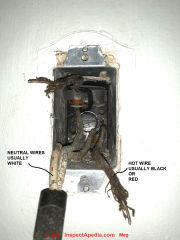 If we can pretend for a moment that the electrical wiring has been installed correctly throughout the building including at this electrical box,
If we can pretend for a moment that the electrical wiring has been installed correctly throughout the building including at this electrical box,
then follow the wires back into the box.
Ground Wire ID: If you see one of the wires connected to the metal box body, typically by a screw or a grounding clip, that should be a ground wire.
Usually the ground wire is bare or sports green insulation or insulation with green and yellow striping.
Hot Wire ID: Another method is to go to the electrical panel and identify the circuit on which this electrical box is wired.
Usually the hot or "live" wire is black, perhaps red, or a combination of red and black.
With power off the electrician would follow the hot wire back to find the cables leaving the electrical panel.
Neutral Wire ID: In the electrical panel neutral wires are connected (usually) to the neutral bus or to a shared neutral and ground bus.
Usually the neutral wire is white.
The electrician might, in the wire cable entering the electrical panel, find the neutral wire and follow in the panel it to its connection on the neutral bus.
There she might temporarily disconnect the neutral wire and cap it.
Now back at the electrical box the ground wire will show continuity to ground using it an ohm-meter or continuity tester, and the neutral wire should not, since it has been disconnected at its other end.
Watch out: if you're not trained and familiar with safe electrical wiring, you should know that you can be shocked or killed.
...
Continue reading at OLD HOUSE ELECTRICAL SYSTEMS or select a topic from the closely-related articles below, or see the complete ARTICLE INDEX.
Or see these
Recommended Articles
- AGE of a BUILDING, HOW to DETERMINE - Visual clues indicate the age of a building
- ELECTRICAL RECEPTACLE TYPES
- OLD HOUSE ELECTRICAL SYSTEMS - home
- 2-WIRE RECEPTACLE CONNECTIONS - no ground
- ALUMINUM WIRING IDENTIFICATION
- AMPACITY AVAILABLE in OLDER HOMES
- ANTIQUE & OLD ELECTRICAL RECEPTACLES
- ANTIQUE LAMPS (BULBS) & CONNECTOR TYPES
- ASBESTOS ELECTRICAL WIRE INSULATION
- ASBESTOS in LAMPS & LIGHT BULBS
- BULB & LAMP TYPES GUIDE - home
- ELECTRICAL COMPONENTS, AGE, TYPES
- ELECTRICAL GROUNDING in OLDER HOMES
- ELECTRICAL OUTLET, HOW TO ADD in OLDER HOME
- ELECTRICAL PANEL AGE
- ELECTRICAL PANEL FUSED NEUTRAL WIRE HAZARDS
- ELECTRICAL SHORT CIRCUITS
- FABRIC NMC WIRE INSULATION IDENTIFICATION - age of old electrical wire by trademark data
- GROUNDING, OLD HOUSE ELECTRICAL
- KNOB & TUBE WIRING
- KNOB and TUBE WIRING, OLD HOUSE
- NUMBER of CIRCUITS in OLD BUILDINGS
- OLD ELECTRICAL BOX TYPES
- OLD ELECTRICAL WIRING HISTORY
- OLD ELECTRICAL WIRING TYPES - timeline of use of different types of electrical wire & wire insulation
- OLD HOUSE ELECTRICAL SYSTEMS - home
- POLARIZED PLUGS, RECEPTACLES, LIGHTS
- SOLID PIPE EDISON DC CABLE HISTORY
- VOLTAGE AVAILABLE in OLDER HOMES
Suggested citation for this web page
OLD ELECTRICAL WIRING HISTORY at InspectApedia.com - online encyclopedia of building & environmental inspection, testing, diagnosis, repair, & problem prevention advice.
Or see this
INDEX to RELATED ARTICLES: ARTICLE INDEX to ELECTRICAL INSPECTION & TESTING
Or use the SEARCH BOX found below to Ask a Question or Search InspectApedia
Ask a Question or Search InspectApedia
Try the search box just below, or if you prefer, post a question or comment in the Comments box below and we will respond promptly.
Search the InspectApedia website
Note: appearance of your Comment below may be delayed: if your comment contains an image, photograph, web link, or text that looks to the software as if it might be a web link, your posting will appear after it has been approved by a moderator. Apologies for the delay.
Only one image can be added per comment but you can post as many comments, and therefore images, as you like.
You will not receive a notification when a response to your question has been posted.
Please bookmark this page to make it easy for you to check back for our response.
IF above you see "Comment Form is loading comments..." then COMMENT BOX - countable.ca / bawkbox.com IS NOT WORKING.
In any case you are welcome to send an email directly to us at InspectApedia.com at editor@inspectApedia.com
We'll reply to you directly. Please help us help you by noting, in your email, the URL of the InspectApedia page where you wanted to comment.
Citations & References
In addition to any citations in the article above, a full list is available on request.
- American Institute of Electrical Engineers. Transactions of the American Institute of Electrical Engineers. Vol. 12. American Institute of Electrical Engineers., 1896.
Cites early electrical patents by Edison, Sprague et als. - Dini, David A. "Residential Electrical System Aging Research Project" [PDF] Fire Protection Research Foundation, Quincy, MA (2008). Retrieved 6/6/2010, original source: http://ul.com/global/documents/corporate/aboutul/publications/newsletters/thecodeauthority/tca_issue_2_2008.pdf
and
The Residential Electrical System Aging Research Project done for NFPA/FPRF is available in its entirety at this site, http://ewh.ieee.org/cmte/pses/ffat/support/RESAReport.pdf - Roger Hankey is principal of Hankey and Brown Inspections, Winter Park, CO. Mr. Hankey is a past chairman of the ASHI Standards Committee and served in other ASHI chapter and national leadership roles. Contact Roger Hankey at: 970-393-6604 - rogerhankey47@gmail.com. Website: www.HankeyandBrown.com Mr. Hankey is a frequent contributor to InspectAPedia.com.
- Norwig, E. A. "Patents of Thomas A. Edison, The." J. Pat. Off. Soc'y 36 (1954): 275.
- In addition to citations & references found in this article, see the research citations given at the end of the related articles found at our suggested
CONTINUE READING or RECOMMENDED ARTICLES.
- Carson, Dunlop & Associates Ltd., 120 Carlton Street Suite 407, Toronto ON M5A 4K2. Tel: (416) 964-9415 1-800-268-7070 Email: info@carsondunlop.com. Alan Carson is a past president of ASHI, the American Society of Home Inspectors.
Thanks to Alan Carson and Bob Dunlop, for permission for InspectAPedia to use text excerpts from The HOME REFERENCE BOOK - the Encyclopedia of Homes and to use illustrations from The ILLUSTRATED HOME .
Carson Dunlop Associates provides extensive home inspection education and report writing material. In gratitude we provide links to tsome Carson Dunlop Associates products and services.




